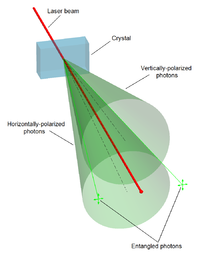
Photo from wikipedia
Spectrally pure photons heralded from unentangled photon pair sources are crucial for any quantum optical system reliant on the multiplexing of heralded photons from independent sources. Generation of unentangled photon… Click to show full abstract
Spectrally pure photons heralded from unentangled photon pair sources are crucial for any quantum optical system reliant on the multiplexing of heralded photons from independent sources. Generation of unentangled photon pairs in gas-filled hollow-core photonic crystal fibers specifically remains an attractive architecture for integration into quantum-optical fiber networks. The dispersion design offered by selection of fiber microstructures and gas pressure allows considerable control over the group-velocity profile which dictates the wavelengths of photon pairs that can be generated without spectral entanglement. Here, we expand on this design flexibility, which has previously been implemented for four-wave mixing, by modeling the use of a static, periodically poled electric field to achieve an effective quasi-phase-matched three-wave mixing nonlinearity that creates spontaneous parametric downconversion. Electric-field-induced quasi-phase-matched spontaneous parametric downconversion enables control of phase matching conditions that is independent of the group velocity, allowing phase matching at arbitrary wavelengths without affecting the entanglement of photons at those wavelengths. This decoupling of entanglement engineering and phase matching facilitates spectrally pure photon pair generation with efficiency and wavelength-tunability that is otherwise unprecedented.
Journal Title: Optics express
Year Published: 2022
Link to full text (if available)
Share on Social Media: Sign Up to like & get
recommendations!